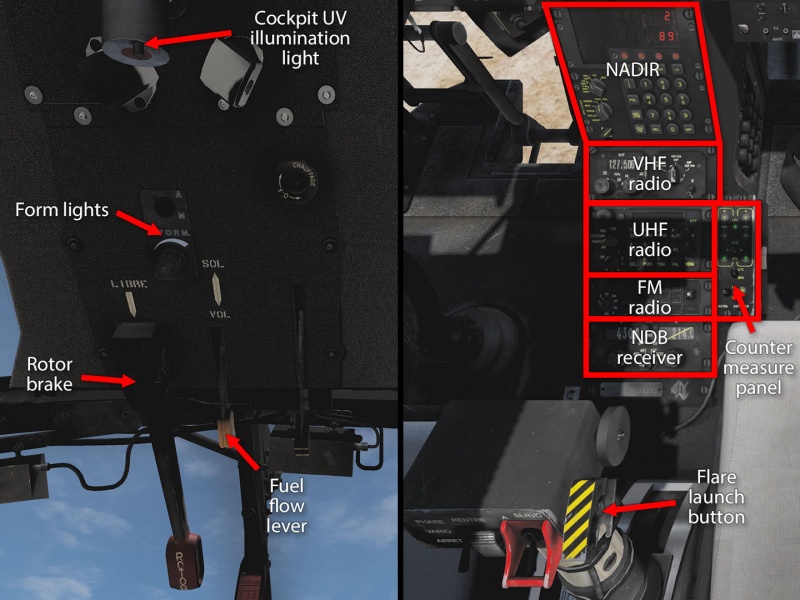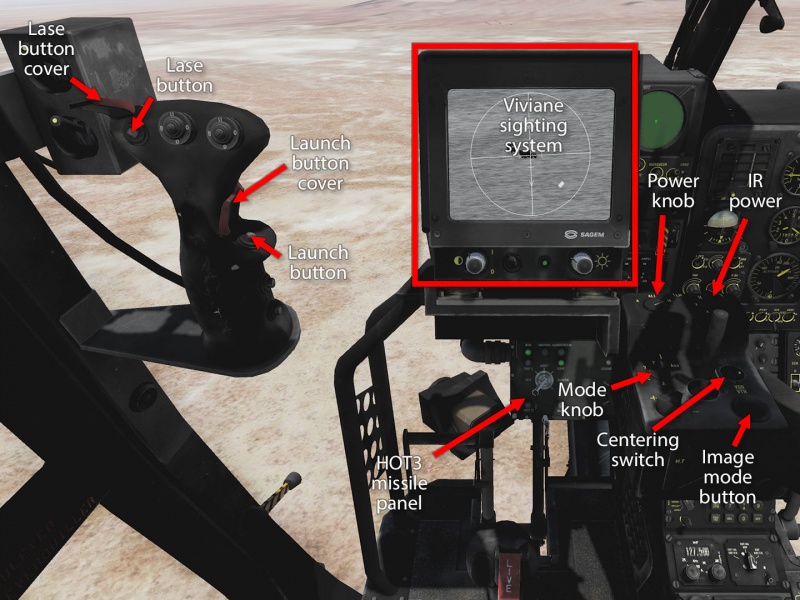SA342 Gazelle
The Aérospatiale Gazelle is a light attack helicopter whose biggest claim to fame is either that it was the airframe that the Blue Thunder helicopter was built on, or its ridiculous speed and fenestron anti-torque device, depending on who you ask. In DCS World, it is represented through four different models, each with its own purpose:
- The SA342L, meant for anti-infantry and light vehicle work using a 20mm cannon and HE rockets.
- The SA342M, meant for anti-armour work with wire-guided HOT3 missiles.
- The SA342 Mistral, meant for anti-air (or at least anti-helo) work using the eponymous Mistral IR missiles.
- The SA342 Minigun variant, meant for… who knows. Spraying bullets all over whatever is on the right side of the helo, or something, maybe?
Features
Between the four different variants, the SA342 comes with a pretty decent selection of tools and functions:
- The DRAX 33 RWR to help avoid threats.
- An advanced stability augmentation system (SAS), including a speed, altitude, and hover autopilot.
- NADIR doppler and gyro navigation system.
- Viviane/Athos sighting systems, and night-fighting capabilities (especially with the HOT3/Viviane combination).
- A wide selection of weapon systems: HOT3 anti-tank missiles; GIAT M621 autocannon + SNEB68 EAP rockets; Mistral IR missiles; or a side-mounted Minigun.
- Multicrew(!) — each crew station can be manned by a different player.
Comes with the built-in campaign Operation Dixmude.
Flying the SA342
The SA342 certainly earns its title as a light attack helicopter, at least in relation to the thrust the engine produces. It is very quick to respond to cyclic, collective, and pedal input, to the point of being rather twitchy. The collective part, in particular, borders on being broken (do not ask about it on forums — wars will ensue) since its DCS flight model enables it to effectively power its way out of VRS just by giving it a bit more welly… and helicopter aerodynamics should not allow that. That supposed power also lets it rocket off the ground at ridiculous speeds, and care needs to be taken when taking off and landing, or you will end up at completely the wrong altitude.
The flip side to that power is that it is fairly easy to desync engine and rotor RPM, which pretty much instantly burns out the clutch and causes the whole bird to lose power. Hope you have practiced your autorotation technique. In particular, this is a very likely consequence of accidentally moving the fuel lever too quickly, or just out of position while in flight — keep this in mind when choosing your binds.
Under less silly flight conditions, its SAS takes the edge of some of its twitchiness, and with all the flight aids turned on it lets the pilot fly pretty much hands-off for long stretches of time. Similarly, at the other end of the spectrum, a hover mode can take over once the pilot has established some loose facsimile of a stable position (low speed, no greater change in altitude, and low pitch/roll angle). From this mode, vertical landings are a cinch, and the entire helicopter can even be slaved to the Viviane or Athos sight systems to ensure it is pointed in the right direction for a good shot.
Cockpit overview
Getting into the air
As far as helicopters go, the SA342 is fairly easy to get started, but it is still a bit of a process and requires some finesse so as to not ruin the vehicle before even getting off the ground. Like most full-sim aircraft, there is a RWinHome “cheat” shortcut that runs through startup procedures for you, and for the full details on what needs to be done, consult the manual or the guide and checklist linked below.
The general gist of if it all is to:
- Close the doors and turn on whatever interior lighting is needed.
- Turn on the battery, alternator, generator, and fuel pump.
- Letting the pump work a little to prime the engine.
- Turning on the engine starter and letting it spool up before releasing the rotor brake.
- Slowly move the fuel lever forward, to get the rotor spinning and then waiting for rotor and engine RPM to sync up.
- Slowly move the fuel lever fully forward while maintaining RPM sync.
(Doing either of the above too quickly will create an RPM mismatch which will immediately and irrevocably ruin the engine — restart or respawn, because you are not going anywhere in your helo now.) - Once the engine and rotors are up to speed, turn the starter off and flip everything else on: pitot heating, trimmer actuators, trimmer magnets, gyros, autopilot, RWR, countermeasures.
- Uncage the ADI:s and turn on the NADIR — testing and programming the navigation system is a whole entire chapter on its own, doubly so if you need to program waypoints manually rather than rely on prepared ones that come with the mission file.
- Hover check and take off.
Note: untrimmed and at hover RPM:s, the torque and tilt of the rotors will make the SA342 want to yaw to the left and roll slightly forwards.
Lift the collective very slowly — keeping in mind how quickly the SA342 will respond — to feel the effect gradually come build up, and apply right pedal and slight aft stick input to counter it.
Shooting something
Links and files
- Tippis' Combined SA342L, M, and Mistral Operator Checklist (see also kneeboard mods).
- Chuck's SA342M/L/Mistral Gazelle guide.
- DCS: SA342 Gazelle by Polychop Simulations in the DCS shop.
More information
- Aérospatiale Gazelle on wikpedia.
- SA 341 Gazelle / SA 342 Gazelle on globalsecurity.org
- Bunyap's Test Flight - DCS: SA342 Gazelle video series.
| DCS World | |
|---|---|
| Helicopter modules (full sim) |
Ka‑50 Black Shark 2 · Mi‑8MTV2 Magnificent Eight · Mi‑24P Hind · SA342L, M, Mistral, and Minigun Gazelle · UH‑1H Huey |






